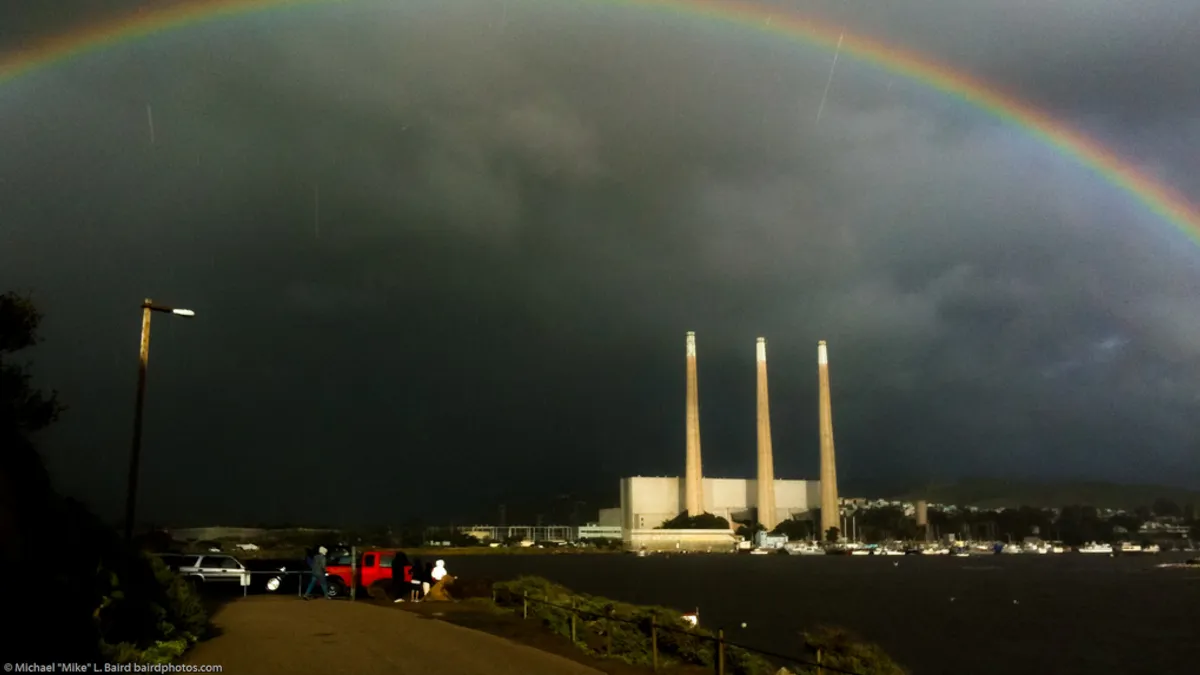Dive Brief:
- Duke Energy today issued its highly-anticipated 2017 Climate Report to Shareholders, outlining how the utility company intends to reduce its carbon footprint, what its generation fleet will look like in 2030, and how the it views more extreme scenarios. The company produced the report following a shareholder resolution that was narrowly defeated.
- Last year, about 33% of the company's generation came from coal, and it plans to reduce that to 16% by 2030, assisted by strong investment in natural gas. Renewables, by that time, will make up 10% of Duke's generation. In 2017, the company's regulated utility generation was about 35% existing nuclear, 1% hydro, 30% natural gas and 34% coal according to calculations in megawatt-hours.
- But the utility giant has also analyzed a scenario based around regulatory limits on carbon, and has concluded it is possible to remove all coal generation from its portfolio by 2050 if renewable energy makes up almost a third of its generation.
Dive Insight:
Duke Energy is not planning to remove coal from its portfolio. It is possible, and the company could do it if required, but the utility makes clear that it examined the scenario only at the behest of investors. The report surrounds the scenario analysis with caveats, renames it and tucks it into the back of the report.
"Duke Energy recognizes that many stakeholders have an interest in understanding how possible future
regulatory limits on CO2 emissions may impact the company’s operations," the report says, leading off a "Two-Degree Scenario Analysis."
The zero-coal portfolio results from an analysis of how Duke could meet CO2 emissions reduction targets intended to limit global warming to no more than 2 degrees Celsius over pre-industrial levels. That's the target set in the United Nations Paris climate accord, which the United States ratified in 2016 and subsequently, under President Trump, withdrew from.
To reach that level, Duke Energy operations would result in an overall emissions reduction of 72% by 2050, compared to 2010 levels, or 74% compared to 2005 levels. Duke refers to this as the “Pro-Rata Reductions” scenario.
To reach the 2-degree goal, the utility said its regulated generation would need to be 31% existing nuclear, 23% renewables, 33% natural gas, and 13% "new load-following zero-emitting" resources by 2050. That could be storage, but the report reveals some skepticism from Duke regarding just how much batteries can really do. So, Duke said the load-following resources could also include zero-emissions generation sources like advanced nuclear, combined cycle gas generation paired with carbon capture.
But the utility cautions, "planning the generation system of 2050 with 2018 technology would be purely speculative." However, it also notes that its current plan to achieve a 40% emissions reduction by 2030 "is consistent with a pathway to achieve a science-based two degree target."
Duke's projected 2030 generation mix
Looking more near-term, in 2030 Duke expects natural gas to make up 42% of its generation, and coal will make up 16%. Hydro, wind and solar will double to 10%, and nuclear will decline slightly to 32% as other sources generate more.
The utility is banking on keeping its nuclear fleet running, and makes a strong case in the report. Through 2017, Duke notes that its nuclear fleet ran 19 consecutive years operating at a capacity factor above 90%. Duke said it is "evaluating the possibility of extending nuclear operating licenses."
Duke also plans to invest $11 billion from 2017 through 2026, in new natural gas-fired, wind and solar generation. And $25 billion across that same time frame will go towards grid modernization, smart grid technologies storm hardening and targeted undergrounding of electric lines.
By expanding energy efficiency programs, Duke also said it expects cumulative energy savings to grow to 22,000 GWh by 2030. By 2024, Duke plans to retire nine more coal-fired units with a total capacity of more than 2 GW.
100% renewables and battery limitations
Duke's report also touches on the recent debate of a 100% renewable energy mix, concluding it may not be feasible.
"We do not believe 100 percent renewables can reliably deliver the power required by a modern economy," the company writes. "Similarly, we do not advocate for 100 percent natural gas or nuclear energy. "
The report predicts that as the adoption of renewables grows to between 20% and 30%, the value of the resource will fall because of larger volumes of excess energy in the spring and fall, and lower winter output. But while energy storage can help address this problem, there are limits, the utility argues.
"While energy storage helps to mitigate the periods of excess and lower output, storage alone cannot address the
energy deficiency during the winter months," the report says. That means, Duke concludes, public policy requiring deep reductions in CO2 emissions "must include sustained financial support for research, development and demonstration to ensure that commercially available technologies exist."














